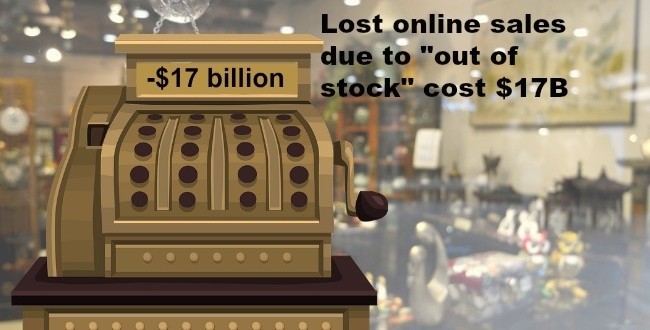 Merchants are losing more than $17 billion in online sales every year due to out of stock products. At retail prices, that number is even larger at $22 billion in lost sales due to unavailable inventory.
Merchants are losing more than $17 billion in online sales every year due to out of stock products. At retail prices, that number is even larger at $22 billion in lost sales due to unavailable inventory.
Those online out of stock rates are twice those of in-store out of stock problems according to new research from the Grocery Manufacturers Association (GMA).
Key findings show online merchant inventory challenges
The report, “A Worldwide Study of Extent, Shopper Reactions, and Implications for Nonfood Online Retail Categories” looked at the availability of products in six non-food consumer goods categories (baby care, fabric care, hair care, oral care, skin care, and shave care) at retailers in the US, UK, China, France, Germany and Japan.
 With the fast growth of online sales, retailers need to take note of key findings in the research study:
With the fast growth of online sales, retailers need to take note of key findings in the research study:
- 20% of inventory globally is out of stock or not-online-available (NOLA) and 15% in the US
- the not available in the store rate in-store US retail stores is 8.3% or nearly half of NOLA
- online, consumers were more likely to consider another brand or substitute another product when online shopping – what researchers call “the Amazon effect”
- in-store, customers were more likely to check another store if encountering out of stock items
NOLA varies widely by country
There were some interesting differences geographically in the level of NOLA according to the report:
“The global level of NOLA is 19.9%. China is the outlier with 31.6% and the highest level of NOLA. Japan has the lowest NOLA level with 13.0%, and the other four countries range between 13.6% (Germany) and 18.2% (France). Items that are Out-of-Stock (OOS), i.e. specifically stated online to be unavailable, account for 8.1%.”
Other NOLA problems
 Researchers identified “voids” as a challenge for online merchants. Voids occur when the product page is not displayed due to unavailability or due to a technical problem with product information. These inaccessible product pages make up 11.8% of NOLA products.
Researchers identified “voids” as a challenge for online merchants. Voids occur when the product page is not displayed due to unavailability or due to a technical problem with product information. These inaccessible product pages make up 11.8% of NOLA products.
Overall, how shoppers view unavailable products varies: stated as out of stock (45%), not displayed (20%), delayed (17%), only available in the store closed (5%) and other (3%).
How do online shoppers respond to NOLA?
 Key to the research findings is how shoppers respond when they encounter products unavailable online.
Key to the research findings is how shoppers respond when they encounter products unavailable online.
- 1% will switch to another online store
- 8% will switch to another product from the same brand
- 8% will switch to another brand
- 1% will switch to another marketing channel such as in-store.
What products are NOLA most often?
Researchers found little variation between products not available online by category.
The overall average of products not available online was 16% and that included: baby products (18%), fabric care (17%), hair care (16%), skin care (15%), oral hygiene (14%), and shaving care (11%).
Brand impact of NOLA impact minimal, except in US
Interestingly, in all non-US countries, the impact of unavailable products on the brand was minimal. In the US, NOLA has a somewhat stronger impact on the long-term loyalty to both the store and the brand.
Product switching psychology
Switching among product categories also presents an interesting insight.
“The first cost is the opportunity cost of not being able to consume the product immediately, the second is the substitution cost of decreased use of a less-preferred alternative, and the third is the transaction cost of the time and effort required to obtain the preferred item. When encountering a NOLA item, shoppers incur these costs, and naturally shoppers will seek to minimize the total of these costs,” the report said.
 Younger shoppers are the most willing to switch brands when products are unavailable, but the research found brand switching decreased with age. By contrast, older shoppers are more willing to delay or cancel a purchase. You could say, those impatient millennials have to have their product as soon as possible.
Younger shoppers are the most willing to switch brands when products are unavailable, but the research found brand switching decreased with age. By contrast, older shoppers are more willing to delay or cancel a purchase. You could say, those impatient millennials have to have their product as soon as possible.
Men are also more willing to switch online stores and less willing to cancel or delay than women. Men are also more willing to switch brands and less likely to pick another brand product than women.
Researchers noted that Amazon Prime members are less willing to switch stores and more willing to find replacement products on Amazon when shopping online.
How to recover lost opportunities
The GMA report assessed the biggest impact of NOLA as lost sales, short and long-term substitution losses for brands and retailers, basket abandonment, search rank impact, and buy box losses.
In addition to the revenue loss, brands and retailers lose equally when shoppers substitute other products or go in search of other sources. This has important consequences for inventory control:
“Often overlooked are the indirect effects of stock-outs. Sales figures for products that are available show the true demand for those items, but when products are not available, the true demand for these items is unknown. When this occurs, the sales figures for this product suggest a lower demand than it is. Worse, if consumers switch to another product, the demand for the other product is inflated as it benefits from the stock-out of the original product.”
Solutions are possible
 Cart abandonment is a recurring challenge for online retailers. Researchers say this is partly due to a large number of consumers opening a cart without real intent to purchase. As well, shoppers finding a product not available early in the shopping trip tend to substitute but are more likely to switch stores leader in their shopping journey.
Cart abandonment is a recurring challenge for online retailers. Researchers say this is partly due to a large number of consumers opening a cart without real intent to purchase. As well, shoppers finding a product not available early in the shopping trip tend to substitute but are more likely to switch stores leader in their shopping journey.
Researchers also found that demand management and product supply issues are the key causes of low online availability. It’s simply more difficult for merchants and suppliers to estimate demand for online products and special online promotions. Merchants and suppliers need to do a better job monitoring inventory and responding quickly.
Another challenge is the accuracy of data or data mistakes that cause product “voids.” The research showed that suppliers often have to provide up to 700 different types of data and content to online merchants. Data preparation is time-consuming and resource intensive.
One solution is to reduce the number of product pages to keep things manageable. Merchants also need to communicate more effectively with suppliers. One online retailer had voided up to 20 items per month without informing the supplier, illustrating the challenge, according to researchers.
Finally, having a dedicated manager for online availability is a high priority and a big step in solving and preventing product availability problems.
 Free report available
Free report available
All in all, it’s a valuable report for online merchants with both insight and suggested strategies to minimize the impact of NOLA.
You can view a copy of the report here.

